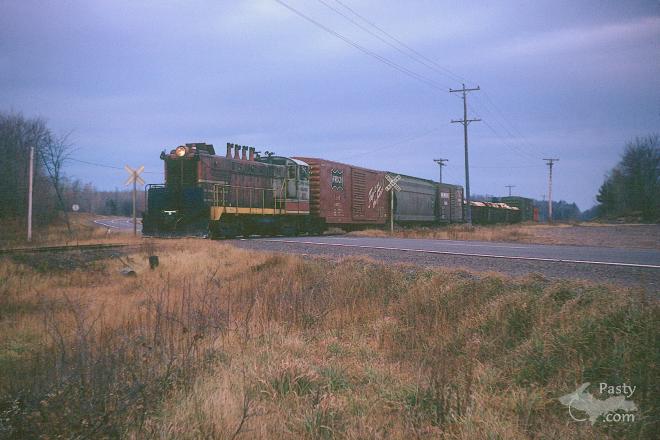By Charlie at Pasty Central (Chopper) on Sunday, November 25, 2012 - 08:15 am:
In last week's Shoebox Memory Peter Ouillette took us back to the final run of Copper Range Railroad, where we met the men at the junction not far from Mass City, who documented the occasion:
This week Peter concludes our reminiscence with scenes that appeared before and after that cigar moment at the junction:The top photo is chronologically the first. This is the last Copper Range train crossing M-26 just south of Toivola, on its way to McKeever to drop off its cars for the next railroad to take to points south.The railroad had a pretty paint scheme for its locomotives. Note the four smokestacks: the engines were nicknamed "church organs" because of the numerous "pipes." A Hancock friend recalled that one could stand on the Hancock side of the canal, look across to the Houghton side, and watch one of these engines pulling a train up the hill from Houghton to Cole's Creek. Working hard, one could watch the "chuffs" of exhaust puff up first from one stack, then the other, kind of like a steam calliope.
Note how times have changed with respect to the amount (or relative lack) of warning signs at the crossing. On this major state highway, all you get for advance notice in 1972 is the simple crossbuck "X" saying "Railroad Crossing." Nowadays this crossing would have lights and bells, perhaps gates to keep everyone safe.This is the final picture. After the picture taken at McKeever, Jim followed the locomotive and caboose on their return trip back to Houghton. On their way they picked up a carload of logs from the (then) new forest products plant between South Range and Atlantic Mine: Northern Hardwoods, which was then part of the Copper Range company. The train crew is finishing up their day as the sunset casts a warm glow on the bridge. You wonder what the men are thinking as they get ready to put away the locomotive in the roundhouse for the last time. In time the railroad yard would be demolished and the Houghton waterfront would be revitalized with homes and the present park and swimming area. This was the end of an era of the industrial waterfront, which had been that way for well over 80 years.
Best Regards, Peter Ouillette
Thanks, Peter, for transporting us back through four decades to this significant moment in time. We will all have a greater appreciation for the changes this region experienced during its transition from mining to tourism to (yet to be determined).
Have a good week :o)





